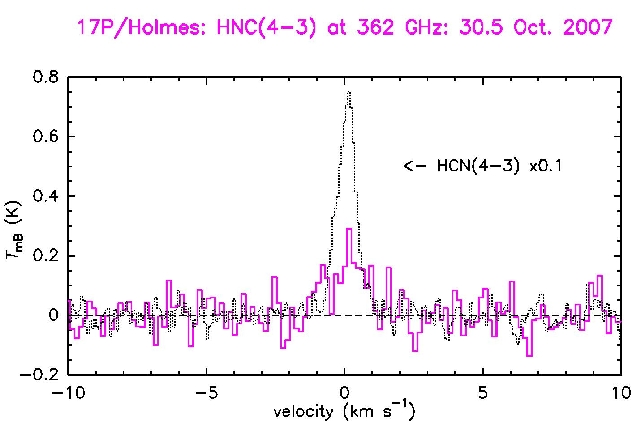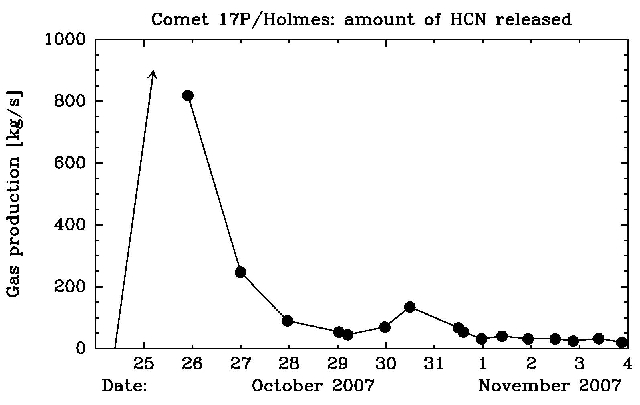
 Studying Astrochemistory on the Exploding Comet 17P/Holmes
Studying Astrochemistory on the Exploding Comet 17P/Holmes 
On October 24th, the
brightness of comet 17P/Holmes suddenly increased by a factor of about
one million in the optical band. It was first reported by amateur
astronomers in Spain. An international astronomy team, led by Drs.
Dominique Bockelee-Morvan and Nicolas Biver at Observatoire de Paris in
France and Drs. Darek Lis and Ruisheng Peng at Caltech used the
10.4-meter Leighton telescope at the Caltech Submillimeter Observatory
and the IRAM 30-meter telescope at Pico Veleta (Spain) in order to
investigate the composition of the comet and better understand what
happened to the comet.
17P/Holmes is a small inconspicuous comet in the Solar System
orbiting around the Sun within a period of 6.9 years. Normally, its
brightness is not more than fifteen magnitudes, making it difficult to
observe without the aid of a large telescope. On October 24th, its
brightness, which was about 16 magnitudes during the preceding days,
unexpectedly increased while the comet was at a distance of 1.63
astronomical units (or 245 million km) from the Earth, and at 2.44
astronomical units (365 million km) from the Sun. It rapidly became
visible to the naked eye, reaching a magnitude of 2.5 on October 25th!
This unbelievable increase in brightness was likely linked to a sudden
disruption of the comet~Afs nucleus, followed by the subsequent
production of a large quantity of small dust grains.
First observations using the IRAM 30-meter radio telescope (Pico
Veleta, Spain) on October 26th revealed intense lines of the CS radical
and of the molecules of carbon monoxide (CO), methanol (CH3OH) and
hydrogen cyanide (HCN), which originate from the sublimation of the
cometary ices. The quantities of observed gases released by 17P/Holmes
were at that date almost similar to those released by comet Hale-Bopp
at its closest approach to the Sun. These molecules were produced by
the evaporation of the dust grains released by the fragmentation of the
comet~Afs nucleus. In order to better understand the fragmentation
process, strong lines of hydrogen cyanide (HCN) were monitored at the
IRAM 30-m telescope and CSO until November 4. The signals which were
measured in the field of view of the telescopes (corresponding to a
projected distance of 12000 km on the comet~Afs surface) decreased
rapidly until October 30, and then faded more slowly. This is
because the gases were first essentially released by small icy grains
that escaped rapidly the field of view. Then, background gases
subliming from chunks of larger sizes slowly expanding in the comet
atmosphere mainly contributed to the signal.
Observations of hydrogen isocyanide (HNC), an isomer of HCN, were
conducted at the CSO. The origin of this molecule in cometary
atmospheres is matter of debate. Its abundance relative to HCN varies
among comets. Measurements in a dozen comets showed that the abundance
of HNC relative to HCN increases with decreasing distance to the Sun,
suggesting that HNC is released by the thermal degradation of grains as
the grains become hotter when the comets are closer to the Sun (Lis et
al. 2007). The huge outburst of comet Holmes provided a unique
opportunity to measure the HNC/HCN ratio for a comet far from the Sun
(2.4 AU). Unexpectedly, this ratio was measured to be much higher than
the value extrapolated from the measurements obtained at smaller
heliocentric distances, implying possibly that other sources of HNC are
present in cometary atmospheres, or that the subsurface layers of
the nucleus of this comet were especially rich in HNC.

Figure 1. Spectra of hydrogen cyanide (HCN) and hydrogen isocyanide
(HNC, in purple) in 17P/Holmes as observed with the CSO on October 30,
2007.

Figure 2. Evolution of the amounts of hydrogen cyanide released
(expressed in kg per second) by comet 17P/Holmes from the peak of its
activity (Oct. 26th, 2007) until November 4th, 2007.
Go back to A Digest of Recent News and
Scientific Results at the Caltech Submillimeter Observatory

 Studying Astrochemistory on the Exploding Comet 17P/Holmes
Studying Astrochemistory on the Exploding Comet 17P/Holmes 

 Studying Astrochemistory on the Exploding Comet 17P/Holmes
Studying Astrochemistory on the Exploding Comet 17P/Holmes 

